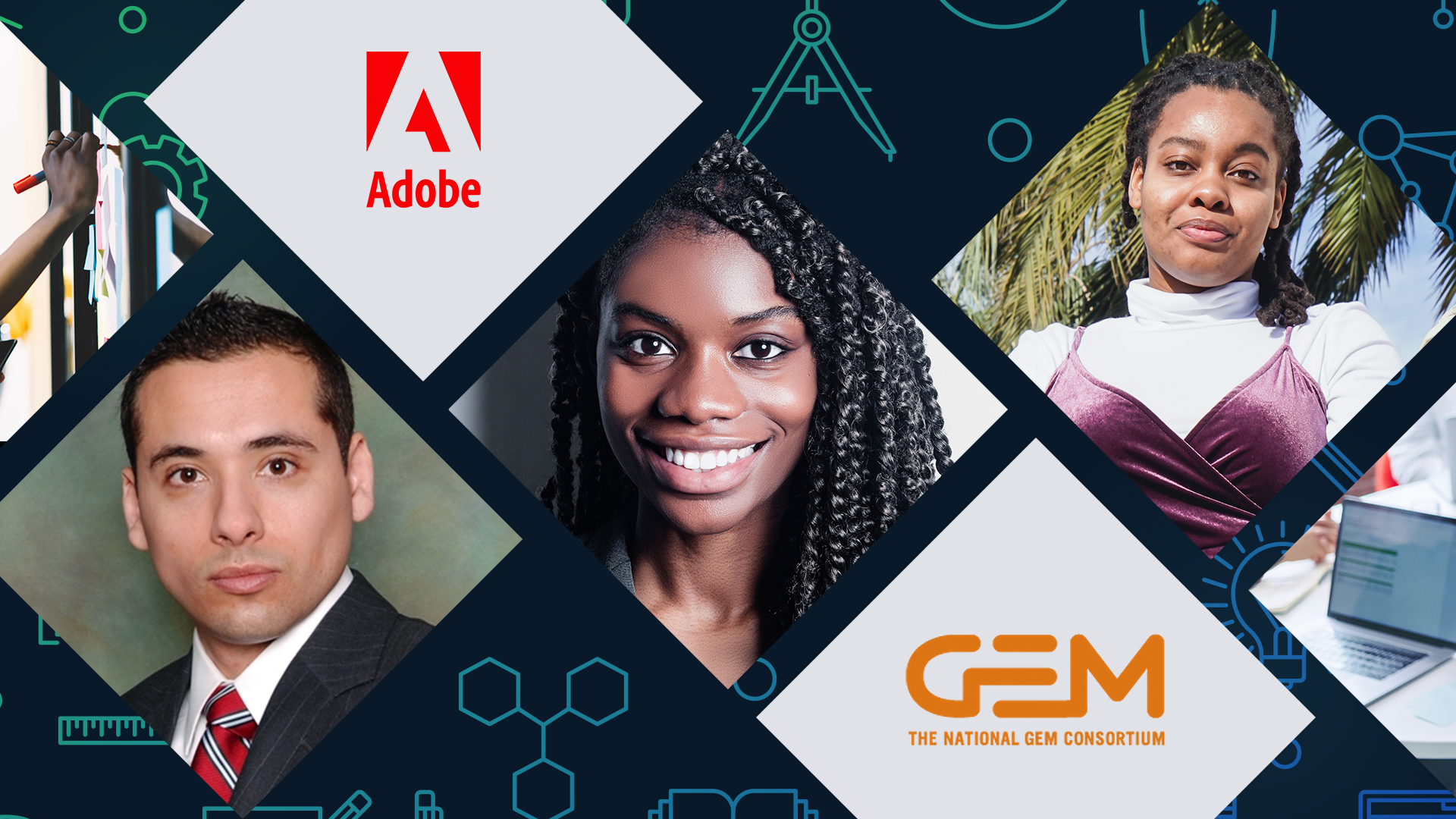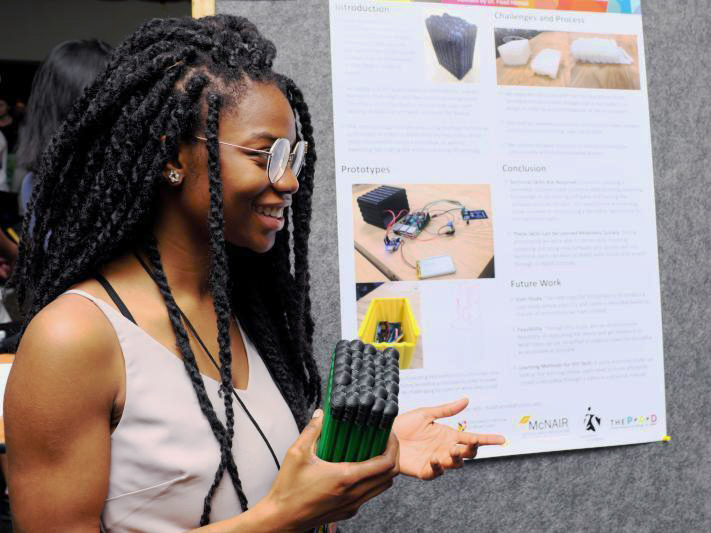
By Meredith Alexander Kunz
From robots to assistive technologies to new AI techniques, discoveries that help people are at the heart of Adobe GEM Fellows’ work. Thanks to Adobe’s support of the National GEM Consortium, the fellows’ graduate studies and Adobe internships are advancing the frontiers of STEM research.
GEM’s network of corporations, government labs, and universities empowers students from underrepresented communities to earn graduate degrees in STEM fields and to do summer internships, gaining real-world experience.
Adobe + GEM
Adobe has sponsored more than 85 GEM Fellows in computer science since joining the consortium in 2012, with a current average of 10 new GEM Fellows each year. Adobe has also hired GEM Fellows as full-time staff.
Applications are open for 2022 GEM fellowships until November 15, 2021, and students who apply now may be sponsored by Adobe for support and internships in coming summers.
The connection between Adobe and GEM continues to grow every year, with each new cohort of fellows bringing fresh aspirations and ideas. This summer, GEM’s CEO, Brennon Marcano, met with Adobe GEM Fellows to learn more about their projects and build the GEM community. “Be who you were meant to be,” Marcano told the fellows. “Make a scientific impact. Make real change in society. I can see here that the GEM legacy is in good hands.”
Good hands indeed: A peek into the stories of a few Adobe GEM Fellows shows the breadth of their efforts.
Giving students a chance
Adobe GEM Fellow Fayokemi Ojo was drawn to STEM when she learned about its many real-world applications. After finishing her undergrad degree in computer science, she got the chance to take part in a special research project in Germany. Ojo helped create a robot to work with children with autism. “Our goal was to teach them about how to have social interactions. We made a working prototype, and now we are doing a research paper about it,” she reports.
Ojo landed a GEM fellowship to continue her studies and is now an incoming PhD student at Johns Hopkins University. How has GEM helped? In addition to financial assistance, the organization encourages students to succeed. “They try to make sure that you select the best graduate program possible and that you have funding for it,” says Ojo. “They really try to give as many students a chance as possible.”
Adobe was Ojo’s top choice for a summer internship during her graduate studies. Working as an intern at Adobe Research helped her learn more about machine learning and neural networks. “I learned a lot about the research process. It’s been a great experience—really challenging, interesting, and exciting. It’s all the things I wanted in an internship,” says Ojo.
She plans to apply what she has learned in graduate school, where she’ll study systems engineering and optimization.
From film to STEM, and back again
For Sola Joshua, his first compelling research idea literally walked right in front of him. Strolling on the Texas A&M campus as an undergrad, he encountered a visually impaired prospective freshman touring the school. “She thought she couldn’t attend the college because it’s so large, and it seemed hard to get around,” he says.
He quickly decided to do something about it, creating a haptic vest to help the student navigate. “It uses voice activation and vibrations on the shoulder blades,” Joshua explains. “I learned a lot about research, the research cycle, and user ergonomic studies.” He produced over a dozen vests that his school still uses.
Joshua initially focused his studies on film and video, and his grades in math and science weren’t the best. In designing sound and lighting for video, he discovered interesting uses for STEM and majored in mechatronics.
He knew he wanted to study human computer interaction (HCI) as a grad student and applied to GEM. “I didn’t qualify for some fellowships. I’d started off with poor grades in STEM. But GEM saw my trend,” says the master’s student, still at Texas A&M.
As an Adobe GEM Fellow, Joshua interned with the Digital Video and Audio team, building new features. Those included assistive technologies for the visually impaired—combining his interests in film, assistive tech, and HCI.
“I loved having the opportunities that interns get at Adobe,” he says. Back in his master’s program, he plans to focus his thesis on accessible technologies for students.
“I realized that this is my passion”
Challenges in the working world can also spark great research ideas. Adobe GEM Fellow Sergio Servantez trained as a lawyer and was practicing law in Wisconsin. That was when he saw that attorneys had to carry around huge books filled with statutes, constantly paging through them to make their case. “It blew my mind. I thought, this is absurd in the 21st century. There should be an app for that on your phone,” he recalls.
So Servantez spent his weekends trying to figure out how to create the app. “I taught myself how to code. I said, ‘I’m going to make this.’ It turned out to be incredibly hard.” But through the process, he discovered something else. “I realized that this is my passion, and this is what I wanted to do for the rest of my life,” he says.
GEM helped him move forward with his new calling. A PhD candidate at Northwestern University, Servantez applied to GEM and became a fellow. Sponsored by Adobe, he was able to advance his research work on AI and law by interning with Adobe Research.
Servantez spent his internship exploring how natural language processing techniques can be used to identify key elements of legal documents. He worked on designing a dataset and building models to evaluate how well AI models can understand these documents. He aims to enable the AI to answer complex questions about the docs, which will require understanding or reasoning over them as a whole.
“This internship has been really transformative for me,” he says. Servantez plans to continue to collaborate with Adobe Research on this ambitious project during the academic year.
A phenomenal summer of growth
Beleicia Bullock almost didn’t apply to grad school—or GEM. But just before the GEM application deadline rolled around, she powered through it, landing a fellowship and sponsorship by Adobe. She is now beginning her PhD at Stanford.
Over the summer, Bullock interned at Adobe for the third time. Following upon two software development internships in Adobe’s Behance, she made the move to Adobe Research.
Bullock’s summer internship project delved into data visualizations in news media. New forms of visualizations in news outlets are personalized for specific readers, raising questions about user impacts. “We’ve seen how personalization can further contribute to polarization, ‘echo chambers,’ and misinformation. Depending on which data you view, you might have completely different insights,” Bullock points out. “It is foundational to ask questions around equity and bias.”
Working at Adobe Research, Bullock upleveled her skills and found herself coming into her own. “It was a phenomenal summer of growth. I can see how this has really taken me to the next level as a researcher.”
The pandemic brought isolation and soul-searching, but throughout, she was able to turn to GEM for support that went beyond dollars. “GEM was such a blessing in the midst of the pandemic,” she says. “It was a lifeline to have this community. You get to show up as yourself.”
